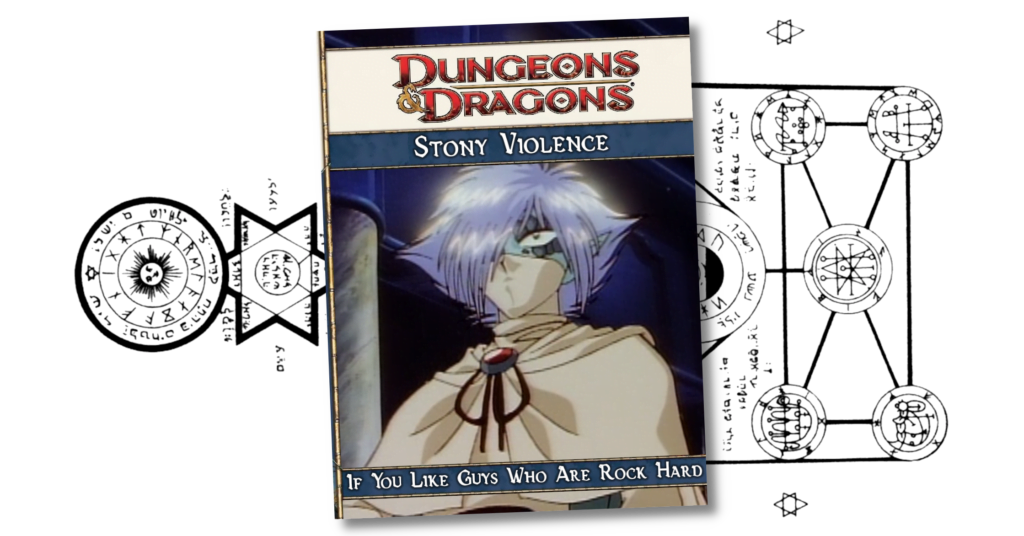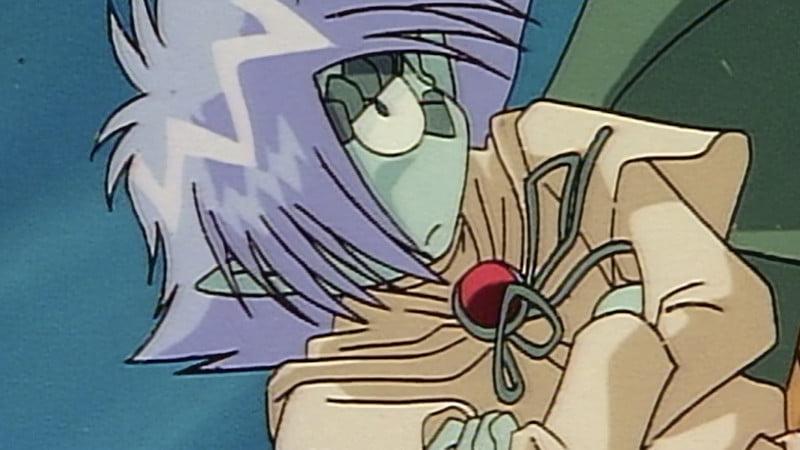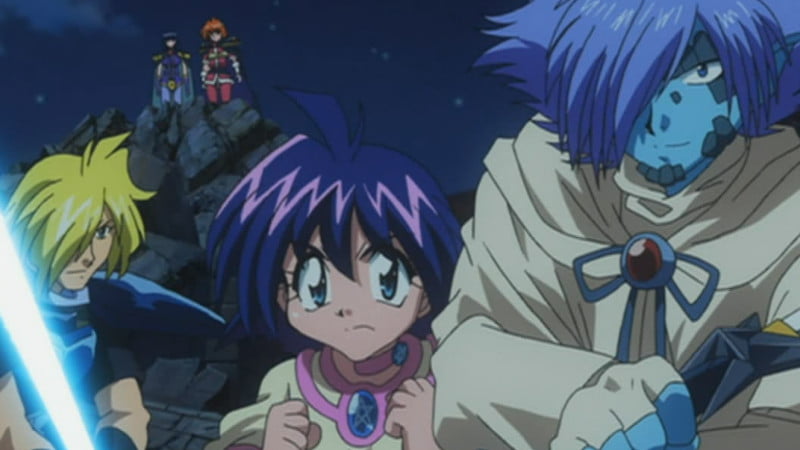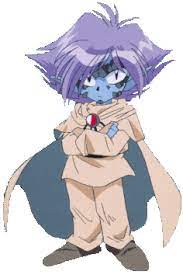In How To Be we’re going to look at a variety of characters from Not D&D and conceptualise how you might go about making a version of that character in the form of D&D that matters on this blog, D&D 4th Edition. Our guidelines are as follows:
- This is going to be a brief rundown of ways to make a character that ‘feels’ like the source character
- This isn’t meant to be comprehensive or authoritative but as a creative exercise
- While not every character can work immediately out of the box, the aim is to make sure they have a character ‘feel’ as soon as possible
- The character has to have the ‘feeling’ of the character by at least midway through Heroic
When building characters in 4th Edition it’s worth remembering that there are a lot of different ways to do the same basic thing. This isn’t going to be comprehensive, or even particularly fleshed out, and instead give you some places to start when you want to make something.
Another thing to remember is that 4e characters tend to be more about collected interactions of groups of things – it’s not that you get a build with specific rules about what you have to take, and when, and why, like you’re lockpicking your way through a design in the hopes of getting an overlap eventually. Character building is about packages, not programs, and we’ll talk about some packages and reference them going forwards.
There’s always going to be a challenge when you translate a character from a game into a different medium. These How To Be articles are about the process of taking a character represented in a fictional form and move them across into the game so that you can connect with their concept in a mechanical space. What, though, if the character started as a mechanical expression and then became part of a fiction?
What is it like to make a D&D character out of a character who is, in a lot of ways, just someone else’s D&D character?
Let’s talk about Zelgadis, from Slayers.
Examining Zelgadis
Zelgadis, if you’re not familiar with him, is a villain-turned hero from the comedy-fantasy 90s anime Slayers, which is an entire anime built around a light novel series about taking the typical loser D&D characters you imagine complete dorks make when given the opportunity to make characters. Zelgadis is a cool, aloof brooding character created by the kind of player who was paying more attention than the others to the rules, and therefore comes across as extremely smug and superior, which is kind of reasonable because he’s also actually pretty damn good at what he does. Not hero-of-the-story good; no, that’s reserved for the role of Lina Inverse, the narrative’s chosen one, but that’s okay.
Also one of his subordinates at one point in the story was a fish-man, which is to say an entire human-sized fish, with human legs hanging out the bottom and arms hanging out the side. Slayers is a weird story, but it’s great the way the story seems to recognise that a lot of D&D players are weird dorks.
Anyway, Zelgadis is the great-grandson of the great villain of the first series, lord Rezo, and he’s been magically experimented on, turning him into a magical chimera.
As you do.
The result is someone who worked for the villains, realised his betrayal, tried to find a cure for his condition, came to work for the heroes, saved the world, and you know the kind of general arc you get out of an anime Ex-Villain. In this case being a 90s anime, he didn’t do anything that seemed too heinous, though the light novels are apparently a bit more interested in unpleasant jokes about what could have happened to Naga or Lina. Not a great look.
Anyway.
Glossary Note: Conventionally, the term used in D&D for this mechanical package is race. This is the typical term, and in most conversations about this game system, the term you’re going to wind up using is race. For backwards compatibility and searchability, I am including this passage here. The term I use for this player option is heritage.
The puzzle of designing Zelgadis comes in three pieces: What is he, what does he do, and how does he do it. This is a little more specific than you think.
What he is, like what is his heritage? He’s a chimera, a mix of things. Literally, he’s unique. There are solutions to that, of varying degrees of untidiness.
Next up, what does Zelgadis do?
Simply put, he’s a wizard with a sword? In Slayers, he casts spells and fights things, and he’s very tough because of his golem skin. At first he’s introduced as a villain, then he becomes an ally and he becomes one of the main characters pretty quickly then. What kind of magic does he do, or rather:
How does he do it?
The books Slayers are based on are while definitely comedies, also deep-nerdy text. Written text allows for all sorts of complex conversations in the moments between moments; you don’t have the animation pushing you forwards to do more with time, you can leave a description or a diagram of a magic system. In an anime, you can’t, because again, propelled forward by time. That doesn’t mean that the rules of the magic system aren’t there in the anime, but it means that sometimes they’re not expressed as clearly, and it can sometimes mean that things done for the way anime does comedy (like pratfalls or explosions) seem to defy the existing rules of the magic system.
What I’m saying is: take it easy.
The Essential Zelgadis
When there’s the issue of heritage, it’s a crapshoot. There is literally nothing in the world like Zelgadis; anything you build onto him is at the risk of not being a satisfying choice for yourself, or your DM. Talk to them about it; I’d personally recommend asking them what heritages don’t show up in their world from the standard books, or that they were never intending to use, then asking if you can re-theme or adjust one of the established ones. Based on that, I’m going to suggest you ask to check out the Changeling, Deva, Genasi or Warforged, all of which can have lore reasons for not being available to other DMs, and which therefore can probably be meaningfully pirated for your Zelgadis uniqueness.
The Warforged is an obvious powerhouse, that is also very good for representing ‘not very human at all.’ There’s a lot of feat support for if you get bored with the baseline version of the heritage too. If you want one that’s simple and won’t get in your way, check out the Firedeath Manifestation Genasi. It’s simple, it’s almost always useful, if you end a fight with it unused, you are not using it aggressively enough.
The big thing is, whatever you choose, you have to be able to trust the DM will never have to be concerned about introducing NPCs and places and people that make you feel like you’re now one in a community. Negotiate with the DM for a way they can keep out of your way, and for you to keep out of theirs.
For the purpose of this examples, though, I am going to assume you’re taking an intelligence-constitution heritage. Zelgadis is very smart, and he’s very tough, even if he’s not extremely strong. His body being tough is vital to the whole of his character.
Zelgadis uses a type of magic that in the universe of Slayers is regarded as shamanism. Shamanism is, in 4th edition D&D, a term used to refer to a Primal Leader’s abilities. That leader works with a thing called a Spirit Companion, and tends to rely on totems and spells that tie into nature effects, including summoning animal-like spirits or invoking nature to heal people. Shamans typically wear armour and shields, and do much of their magic through a third person entity. What Zelgadis does in Slayers is instead a range of spells that are driven by incantations, a personal spring of magical power (amplified by his being part-Blow Demon, yes, really, that’s what it’s called), and that power is divided up into discrete orders of magic, based on elements of wind, water, fire, and earth.
You can follow the path that the words push you down, or you can look at the outcomes of the use of the kind of magic he does. For this purpose, and given the way shamans just don’t do things that look like how Zelgadis does things, I’m going to look at the Arcane power source for classes that fit Zelgadis.
Zelgadis uses a weapon (a sword), and he uses magic interchangeably. When he does use the sword it’s often as an actual sword, not as some kind of focus or magical spellcasting thingy. In arcane classes, there are a couple of options that work for this, but remember: Zelgadis is also absolutely a powerful spellcaster. The sword could be a focus or a backup.
This gives us some pretty open spaces, but we can nonetheless look at them in light of our current ‘package’ design. If our heritage option is +Int or +Con, then the classes I’d look at are as follows.
Swordmage
While the Swordmage is the class most likely to start working exactly the way it should straight out of the box, it is also a class with its own problem. You have a sword up front, and you can have at-will powers that both let you ‘cast spells’ in the form of arcane ranged attacks and magical melee attacks. Your intelligence is important, you can wear armour that will help reinforce your Zelgadis-a-like being very tough, and you’ll benefit from a good constitution as well.
The Swordmage does have a theme of teleporting a lot, which may not work so well for you. We do see Zelgadis do ‘fast anime movement’ style, and that for me feels very much like it should be a teleport, but you may not appreciate it. The fact he keeps his other hand free works well with the Swordmage needing to keep a hand free for optimal spellcasting.
Bard
The problem I see with the bard is that to get the feeling of Zelgadis the best, you have to make a build of the character that will ask a lot of you and if you’re keen on optimising the way your character works, you might have to be good at a few things rather than great at one thing. Me, I’m the kind of player who tries to build so I only need one or two ability scores, as high as possible, rather than try to satisfy the needs of a number, so I would prefer not to do this. Still, the bard:
- Is an arcane caster
- Can use a sword
- Can be tough with Virtuous bard abilities
- Can benefit from Intelligence and Constitution scores
It also is a leader, which means that you can fill a role in the party that Zelgadis does, and there’s an option to learn rituals, so you can chant big ridiculous spells the way Zelgadis does out of combat. Overall, it’s a strong choice especially given how little it needs to be perfectly good at its job.
The other wrinkle is that a bard is a high-Charisma class, and Zelgadis… look, Zelgadis doesn’t feel like he’s high-Charisma to me, but he just falls into that role naturally because they’re all such colossal dipshits.
To simplify, then, bard serves well here, and can probably hit all the Zelgadis notes you want, but may have too much ‘other stuff’ to really carry the feeling. You get to choose. Personally, I like having more options and I like playing leader classes.
Warlock
You can build a Warlock that wants to use a weapon straight away, with Eldritch Strike. Eldritch Strike is a classic poached power from the Warlock, as it’s one of the only ways for some builds to conveniently get a Constitution-or-Charisma based melee basic attack, and it has a slide as well. You can tie into all sorts of slide-based power options if you go Warlock.
The pact you want to look at here is the Vestige pact, because it often involves casting spells with someone’s name attached, then, as a vestige pact warlock, getting some special addition that feels like that person’s being summoned. In the Slayers universe, this is what whe’d normally associate with Black magic, which is much more Lina’s field, and you don’t necessarily have access to a full suite of elemental damage types the way that Zelgadis necessarily would.
You get curses as well, which can work as small minor spells cast while you move around the battlefield, choosing your targets.
There’s also a modest concern from some that the Warlock, when turned into a pure number-crunching machine, is ‘not optimal’ compared to other caster damage dealers. This is perhaps true, but games aren’t played by spherical characters in a vacuum: A Warlock is going to have as much chance to do something cool in a battlefield with the tools they have and the fact that over time you’re missing out on 3 DPA or something is not important for most game play situations.
Finally, Warlocks have access to Ethereal Sidestep, an at-will teleport 1, which if you remember our Corvo article, is a really strong thing to have access to that lets you trigger a bunch of cool effects.
Junk Drawer Options
Obviously, you can pick up a totem spear, shape it like a sword, and go Shaman. The actual Shaman class with its big spiritual emissary could use some changed flavour, and there is a theme, the Elemental Priest, which summons spirits and then dismisses them like incantations and zones that drive the powers of a spell.
If you’re looking for optimal numbers and you want to be a tough spellcaster, you could also look at the Dragon Power Sorcerer. The blasting capacity is unbeatable, and being built around Strength, which lets you still have some of that toughness that’s important.
Finally, while I really like the Artificer for representing a ‘smart’ character like Zelgadis, that class is one that tinkers on magic and crafts it, which I like to represent Zelgadis making small magical prisms or devices with contained spells, but it may just have a few too many gears on it for you.
It’s funny, isn’t it? Zelgadis basically is a D&D character, but translating him from one format to this was an absolute strain. Not because the system can’t represent him – but rather, how, in the anime and source material he’s from, Zelgadis is limited. There’s a lot of stuff Zelgadis doesn’t do that a D&D character would be expected to do.
Part of this is because the Slayers party is, essentially, five damage dealing thieves who are also immense idiots.
This article was reposted from Talen’s personal blog.
You can find the original at Press.exe








